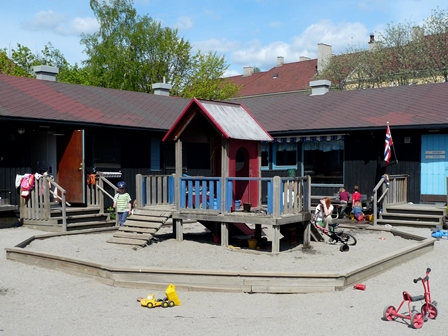Available outdoor space and competing needs in public kindergartens in Oslo
DOI:
https://doi.org/10.7577/formakademisk.601Emneord (Nøkkelord):
children’s right to play, outdoor play area, parking, space discourseSammendrag
To be able to plan a diverse and flexible environment in kindergartens for children from 1 to 5 years of age, available and adequate space is needed, preferably an open and coherent space adaptable to change. Hence, size itself is a factor to control and regulate to ensure that children’s needs are met. The aim of this study was to investigate how the utilization of outdoor space responded to changes in applied norms and law over time. The hypothesis was that needs for space of a more administrative nature, such as parking, have been prioritized over play area. To test this hypothesis, 201 public kindergartens in Oslo’s outer city that offer full-day service were studied. The main findings were that the gross size of kindergartens in Oslo decreased by 12.6 m2 per child for those built after 2006 compared to those built before 1975, due to legal changes in these time intervals, and that play space per child constituted more than half of this decrease. In the same time period, the reduction in space for parking and roads on the premises decreased by only 1.6%. This finding suggests that norms founded in laws win the battle over space, even if this indirectly compromises the meeting of children’s needs for an adequate outdoor play area.

Nedlastinger
Publisert
Hvordan referere
Utgave
Seksjon
Lisens
- Forfatteren(e) beholder sin opphavs- og kopieringsrett til eget manuskript, men gir tidsskriftet varig rett til 1) å fremføre manuskriptet for offentligheten i den opprinnelig publiserte digitale form, og 2) å registreres og siteres som første publisering av manuskriptet.
- Forfatteren må selv forvalte sine økonomiske kopieringsrettigheter overfor eventuell tredjepart.
- Tidsskriftet gir ingen økonomisk eller annen kompensasjon for innsendte bidrag, medmindre det er gjort særskilt avtale om dette med forfatteren(e).
- Tidsskriftet plikter å arkivere manuskriptet (inklusive metadata) i den opprinnelig publiserte digitale form, i minst ett dertil egnet åpent tilgjengelig langtidsarkiv for digitalt materiell, som for eksempel i de norske universitetenes institusjonsarkiv innen rammen av NORA-samarbeidet.
Verket vil bli publisert OpenAccess med en Creative Commons 4.0-lisens som tillater alle å lese, dele og tilpasse innholdet, også kommersielt, under lisensvilkårene:
Dette verket må tilskrives/ krediteres på riktig måte, en lenke må gis til CC-BY 4.0-lisensen, og endringer som er gjort må angis på en rimelig måte, men ikke på noen måte som antyder at lisensgiveren støtter deg eller din bruk.



